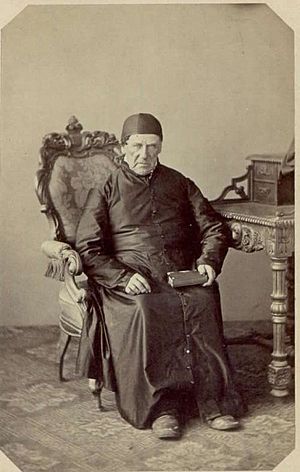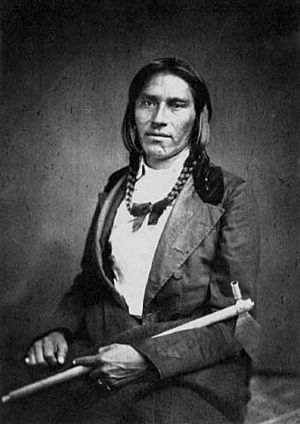Hole in the Day facts for kids
Hole in the Sky (born 1825, died 1868) was a very important chief of the Ojibwe people, a Native American group in Minnesota. His Ojibwe name has been spelled in different ways, like Bagone-giizhig. He was also known as Hole-in-the-Day. This special name came from a dream where a guardian spirit was seen through a hole in the clouds. It also refers to a group of stars called the Pleiades, which the Ojibwe also call by the same name.
Contents
Becoming a Leader: Hole in the Day's Journey
In 1847, Hole in the Day (the Younger) took over from his father as the main chief of the Mississippi Band of the Ojibwe. This group lived in central Minnesota. Like his father, Hole in the Day the Younger was known for fighting against the Dakota people. He also played a big part in talks with the Dakota and with the U.S. government.
Hole in the Day the Younger really wanted to be seen as the main chief for all Ojibwe in Minnesota. Many U.S. government officials actually thought he was the most important chief. This was because he tried to be involved in almost all important talks between the Minnesota Ojibwe and the U.S. government. He also spoke very clearly and acted in a dignified way. However, many other Ojibwe leaders in Minnesota did not agree that he was their main chief.
His Family Life
Hole-in-the-Day had several wives. Some stories say he had as many as eight, while others say five. What everyone agrees on is that one of his wives was a white woman who was Catholic and Irish-American. He married her while traveling in the eastern United States. She might have worked as a journalist. It's not clear if she was born in Ireland or if her family just came from there.
Some records also call him Joseph Hole-in-the-Day. He was thinking about becoming Catholic when he died, but he had not yet been baptized.
The Dakota War of 1862

During the Dakota War of 1862 in Minnesota, Hole in the Day the Younger suggested that the Ojibwe should join the Dakota people. He wanted them to work together to make European settlers leave Minnesota. He even threatened to attack and take over Fort Ripley, which caused a lot of worry there.
To get more Ojibwe to join the fight, Hole in the Day spread a false rumor. He said that the Union Army was forcing Ojibwe men to become soldiers in the American Civil War. Because of this rumor and Hole in the Day's strong words, a group of Ojibwe from Leech Lake burned the Indian Agency in Walker, Minnesota. They also took some people prisoner and marched to Crow Wing.
However, most other Ojibwe chiefs did not want to go to war against the United States government. Many Ojibwe warriors actually went to Fort Ripley to help protect it from a possible attack by Hole in the Day's supporters. When others couldn't make peace, a Roman Catholic priest named Fr. Francis Xavier Pierz went to Chief Hole in the Day's camp. He convinced the Chief to go with him to Crow Wing and sign a peace agreement with the U.S. government.
The Assassination of Chief Hole in the Day
On June 27, 1868, Chief Hole in the Day left his home at Gull Lake. He was in a buggy driven by his trusted cousin. They were on their way to Washington, D.C.. The Chief planned to talk about a new agreement for the Ojibwe to move to the White Earth Indian Reservation. He had told his people not to move to White Earth until the U.S. government built everything they had promised on the Reservation.
Near the Crow Wing Agency, a group of twelve armed men from the Pillager Band blocked the buggy's path. The Chief, who had left his gun at home, stood up and called out in the Ojibwe language, "You found me at a bad time! I am unarmed!" One of the Pillagers then shot him. After the Chief fell, another Pillager made sure he was dead.
After the murder, the attackers went to Hole in the Day's house and stole things. His cousin warned them not to kidnap one of the Chief's young wives, which stopped them.
Why No Arrests Were Made
The murder of Hole in the Day happened on Native American land and involved Native American people. Because of this, the U.S. government had little power to arrest or punish the attackers. Even so, they tried to arrest them. But the Chief of the Pillager Band refused to hand them over. He said that if he did, only the attackers would be punished, and the people who hired them would not be tried.
Where He Was Buried
Hole in the Day's son, Ignatius, had become Catholic. He asked Fr. Francis Xavier Pierz to bury his father in the Catholic cemetery at Old Crow Wing. However, in 1957, someone illegally dug up the grave looking for old items and found no body.
According to Ojibwe writer and historian Anton Treuer, the stories passed down in Hole in the Day's family say something different. His non-Catholic relatives did not like Ignatius's choice of burial. They secretly dug up and moved the Chief's body. They reburied him according to traditional Ojibwe customs in a secret place near White Earth.
The Mystery Solved
Hole in the Day's murder was big news across the country. Many people wondered why he was killed. Some thought it was due to personal jealousy. Others believed it was because he claimed to be the main chief of all Ojibwe for many years. Some thought it was revenge for the attacks he started in 1862. Another idea was that it was because he wanted to keep certain mixed-blood Ojibwes, or Métis, off the White Earth Reservation and off the government payment lists. After his murder, these same mixed-blood people moved onto the reservation.
For many years, the reasons for the Chief's murder remained a mystery. The names of the attackers were known, but no one was ever charged. In 1911, the surviving attackers finally spoke out. They said that the 1868 murder of Chief Hole in the Day was a contract killing. This means they were hired by a group of businessmen and traders. These men were led by Allan Morrison and Clement Hudon Beaulieu, a powerful local politician. Beaulieu had said that Chief Hole in the Day was like a big log blocking their way. If he wasn't killed, Beaulieu and his friends couldn't get what they wanted.
According to Anton Treuer, by 1911, all the attackers regretted what they had done. Beaulieu and his friends had not kept any of the big promises they made to them. Also, Beaulieu and his group had taken control of the government, law enforcement, and businesses on the White Earth Indian Reservation. They became rich by cheating and making others poor.
In 1911, the surviving attackers testified because they had realized something important. They saw that Chief Hole in the Day was able to make the U.S. government keep its promises to the Ojibwe people. They also saw that he could keep Clement Beaulieu and his friends from taking over. For all these reasons, even the Chief's murderers had come to miss him.
Anton Treuer has said that the Chief's murder was a turning point for the Ojibwe people. He believes that what happened after the murder was a big reason for the loss of the Ojibwe language and the decline of Ojibwe culture. Treuer has worked hard to find the truth because he believes that understanding the past is important to save what remains and to find what has been lost.
Other Chiefs Named Hole in the Day
Besides Hole in the Day the Elder and Hole in the Day the Younger, there were at least two other important Minnesota Ojibwe leaders in the 1800s named Hole in the Day. One Hole-in-the-Day from Red Lake was involved in the Nelson Act of 1889. Another Hole-in-the-Day from Leech Lake played a key role in the Battle of Sugar Point in 1898.


